#enchodus
Explore tagged Tumblr posts
Text
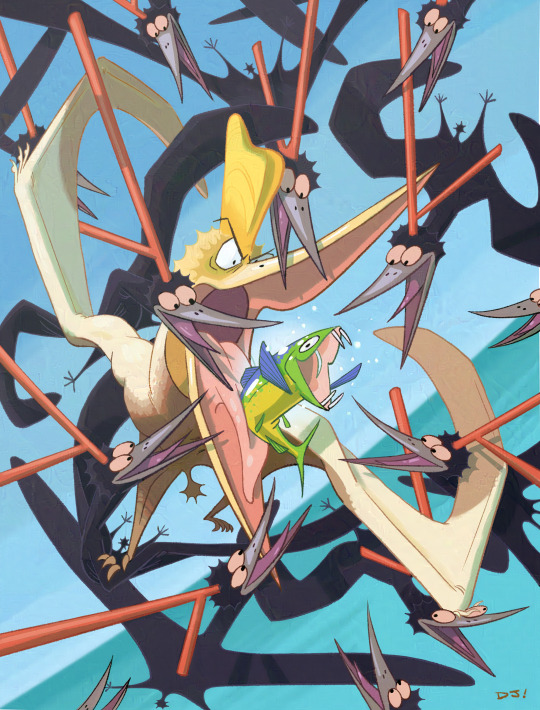
Kleptoparasitism. Pteranodon, Nyctosaurus, Enchodus
4K notes
·
View notes
Text




My 25 years of palaeoart chronology…
Here are some zooms into my 2021 painting of Platecarpus hunting an Enchodus. This piece was commissioned by the Children's Museum of Indianapolis, USA.
#Art#Painting#PaleoArt#PalaeoArt#SciArt#SciComm#DigitalArt#Illustration#Dinosaurs#Birds#Reptiles#Palaeontology#Paleontology#Platecarpus#Enchodus#Mosasaur#Mosasaurus
209 notes
·
View notes
Text

Gerrothorax, Pterygotus, Pikaia, Enchodus, Hallucigenia, Arganodus, Tullimonstrum, Haimirichia, Hibbertopterus, Amiskwia, Opabinia, Hyphantoceras, Ottoia, Tiktaalik, and Cameroceras! Not to scale.
Honestly if I knew I was gonna add so many for this one I would’ve made more room
#gerrothorax#pterygotus#pikaia#enchodus#hallucigenia#arganodus#tullimonstrum#haimirichia#hibbertopterus#amiskwia#opabinia#hyphantoceras#ottoia#tiktaalik#cameroceras#paleoart#digital drawing#digital doodle#digital doodles
58 notes
·
View notes
Text

Posting the whole page of all the requests and just ones I wanted to do in the Paleo Pines style! Probably going to make more cause this is really fun (Designs not to scale but Im sure you all know lol)
#paleo pines#dinosaur#amphibian#synapsid#pterosaur#marine reptile#fish#Ophthalmosaurus#gorgonopsid#gorgonops#kaprosuchus#scutosaurus#prionosuchus#cartorhynchus#ichthyovenator#enchodus#jeholopterus#sinosauropteryx#austroraptor#diabloceratops#halszkaraptor#regaliceratops#cephalapsis#art#my art
108 notes
·
View notes
Text
Month recap time!
This month's drawings:
- Johanna plays with some baby Scutosaurus
- Two male Enchodus try to woo a female, but scare the crap out of David
- Frida falls for a booby trap and is now the subject of interest of a Camptosaurus
- A baby Isisaurus thinks Twig is its parent




#drawing#dinosaur#hilda netflix#prehistoric planet season 2#life on our planet#johanna hilda#david hilda#frida hilda#twig the deerfox#Scutosaurus#Enchodus#Camptosaurus#Isisaurus
22 notes
·
View notes
Text













Enchodus is an extinct genus of aulopiform ray-finned fish related to lancetfish and lizardfish which flourished during the cretaceous some 113 to 66 million years ago. Potentially the latest Enchodus remains are known from the earliest Eocene of Barmer, India some 50 million years ago, however its been been suggested that all post-Cretaceous Enchodus records are reworked cretaceous material that ended up in cenozoic deposits via geological uplifting and other processes. The first remains of enchodus consisting of a partial skeleton was recovered from Mediterranean deposits then described by Jean Louis Rodolphe Agassiz in 1835 who named the animal Enchodus from Greek enchos meaning spear and odoús meaning tooth. Since then remains have been found throughout North America, Europe, South America, Africa, the Middle East, India, and Southwest Asia. And today at least 29 species representing two distinct clades are known. Reaching around 2.5 to 5.6ft (76.7 to 172.2 cms) in length, Enchodus were small to medium sized fish whos most notable attributes are the large "fangs" at the front of the upper and lower jaws and on the palatine bones, leading to its misleading nickname among fossil hunters and paleoichthyologists, "the saber-toothed herring". These fangs, along with a long sleek body and large eyes, suggest Enchodus was a predatory species and would have given it an appearance somewhat reminiscent of modern deep-sea fishes, such as anglerfish and viperfish. Despite being a formidable predator, remains of Enchodus are commonly found among the stomach contents of larger predators, including sharks, other bony fish, mosasaurs, plesiosaurs, pterosaurs, and seabirds.
Art Used can be found at the following links


#pleistocene pride#pliestocene pride#enchodus#extinct#prehistoric#fish#animal facts#fossil#paleontology#paleoart#western interior seaway#marine life#sea life#sea creature
5 notes
·
View notes
Text
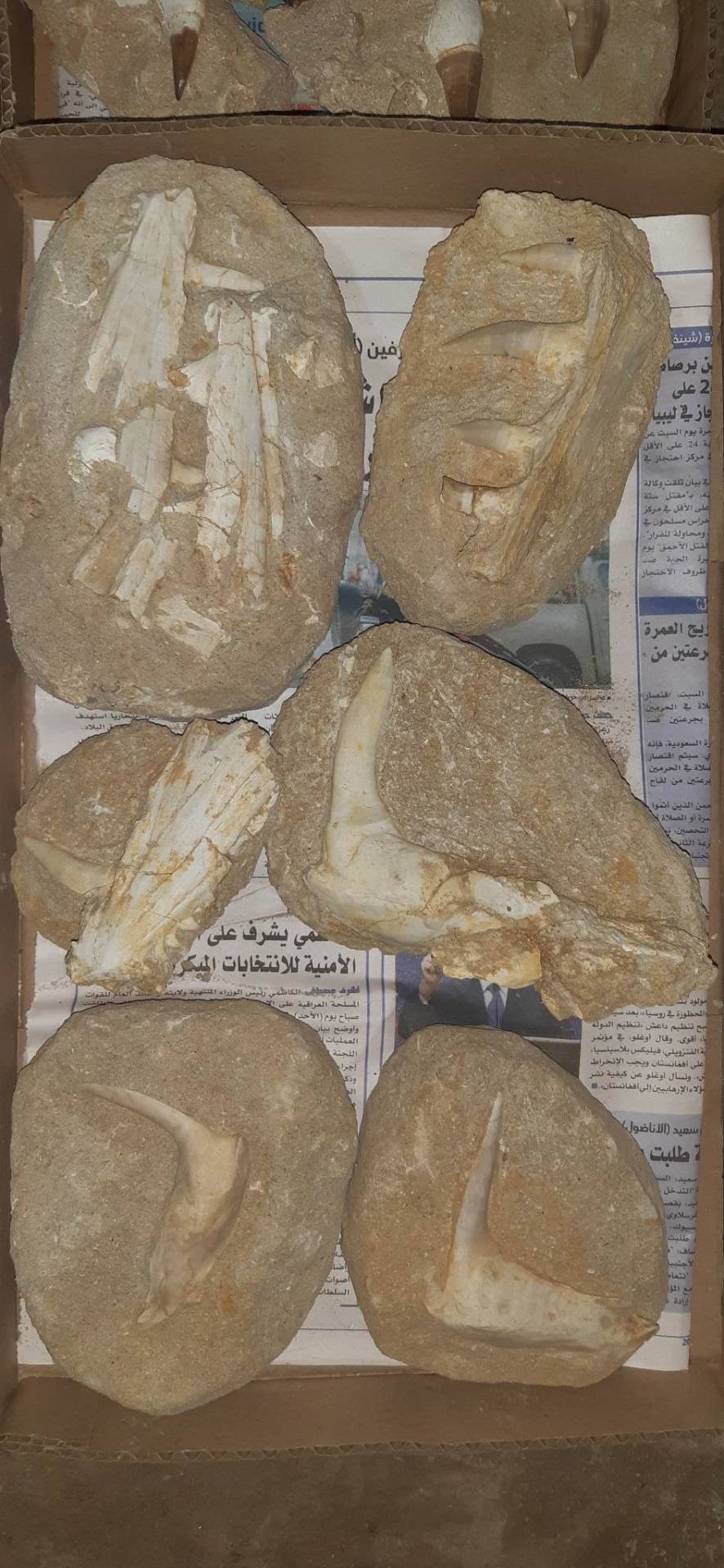
Enchodus fossil fish bones
7 notes
·
View notes
Text
Enchodus gladiolus i did as a part of my internship with the Edelman Fossil Park. Done in Clip Studio Paint
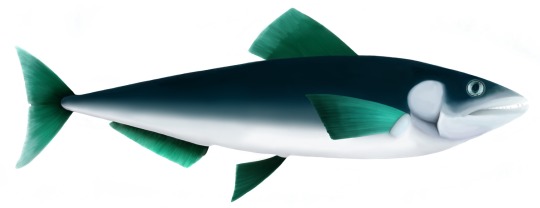
5 notes
·
View notes
Text



To give you an idea how incredible the preservation of the fossils from Sendenhorst and a few other localities here is: have some more examples.



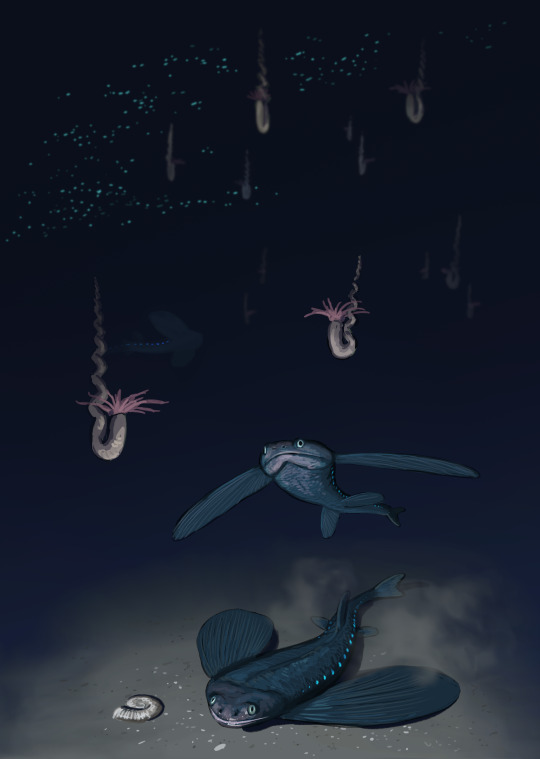
We know little about the deep sea environments of the Mesozoic but one place where we can get a glimpse into this world is the Münsterland basin. We have here several localities that preserved shallow and deep water animals side by side, caused by underwater landslides. These carried stuff from the rim of the basin and buried them in the deep with other material that was down there.
Tachynectes here is a very early lanternfish. Flattened lanternfishes are no longer a thing these days and we actually have lanternfishes from these localities that show their photophores preserved. We know where they glowed!
#sciart#paleoart#cretaceous#münsterland basin#fish fossils#fossils#paleontology#sendenhorst#enchodus
5K notes
·
View notes
Text
Fortune Seeker
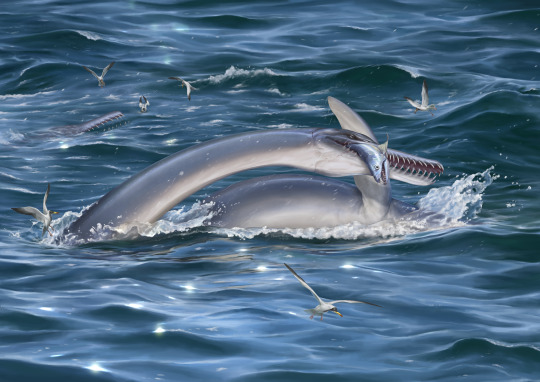
A group of Serpentisuchops seeking fortunes at the open sea hoping to find more food sources,
Lucky for them, underneath that flock of Ichthyornis there are Enchodus waiting for weary ichthyornis to be swoop at.
Serpentisuchops Pfisterae is a genus of Polycotylid Plesiosaur from Late Cretaceous and know to dwell the Shallow Sea of Cretaceous North America.
23 notes
·
View notes
Text




I dunno about you guys, but with this year possibly being a big one for paleomedia as a whole (A new Jurassic World movie, ON TOP of two big budget paleodocs being the main examples), perhaps we could FINALLY see PHP return for a third season. While I'm not gonna go ramble on about how I think this hypothetical Season 3 will be the last one to close out the series (along with cementing a trilogy in the same vein as Planet Earth), I am gonna bring up a little thought experiment that me and some of my Discord buddies came up with and discussed.
I've heard quite a few folks say that they want PHP to move away from the Maastrichtian epoch from the end of the Cretaceous, but I've also seen people mention how this particular chunk of geologic time still has plenty of usable taxa to put in the show, even after 2 entire seasons' worth of species. Not only are many dinosaurs still left on the table, so are many non-dinosaur animals as well; Pterosaurs, marine reptiles, mammals, fish, birds, etc. This is just a quick lil' list to point out the candidates that could appear in future episodes, as a huge part of me feels like the show is gonna remain within the Maastrichtian for the time being. And for a funny coincidence, the amount of animals that I was able to put together between my own research and suggestions from?
SIXTY. SIX.
As in, the geologic time that the entire show takes place in ("Planet Earth, 66 million years ago" and all that). You can imagine the surprise that I had when I accidently reached that number.
Anyhoo, let's hop to it
Ankylosaurus
Gallimimus
Dryptosaurus
Ocepechelon
Arambourgiania
Denversaurus
Thescelosaurus
Rhabdodon
Shantungosaurus
Coahuilaceratops
Leptoceratops
Regaliceratops
Alaskacephale
Ampelosaurus
Noasaurus
Alioramus
Falcatakely
Torosaurus
Patagonykus
Epapatelo
Mahajangasuchus
Zarafasaura
Gavialimimus
Champosaurus
Habrosaurus
Didelphodon
Bharattherium
Purgatorius
Cretalamna
Stratodus
Pycnonemosaurus
Maip
Stegorous
Thalassotitan
Ajnabia
T. mcraeensis (As in, the new Tyrannosaurus species described in 2023)
Khinjaria
Eoneophron
Patagomaia
Augustynolophus
Plotosaurus
Pleisotylosaurus
Tylosaurus
Hydrotherosaurus
Morenosaurus
Anzu
Bonnerichthys
Sinoceratops
Zhuchengtyrannus
Acheroraptor
Saurolophus
Thoracosaurus
Borealosuchus
Armadillosuchus
Saltasaurus
Palaeosaniwa
Avisaurus
Potamornis
Brachychampsa
Enchodus
Alphadon
Adocus
Serpentisuchops
Charonosaurus
Asteronis
Sahonachelys
Like I said; 66 different species just WAITING for their time to shine. And given how it's almost been 3 years since the show originally came out, the same timeframe that S1 had between 2019 and 2022 could also apply to this hypothetical third season (and this theory is helped even more by the idea that S2 was originally material that was scrapped by S1).
We've got a full year to wait and see if we get anything new with this show, so we've got plenty of time to speculate before we find out anything.

Many thanks to my Discord peeps for coming along for this fun thought experiment. You guys rock!
3 notes
·
View notes
Text
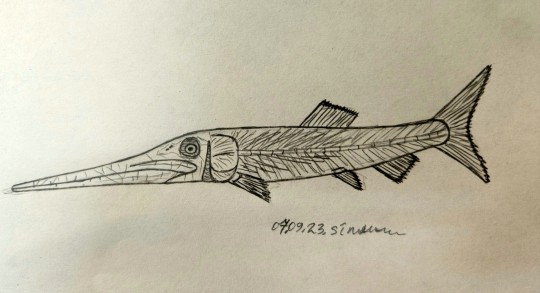
My take on Apateopholis laniatus
Funky enchodus relative
13 notes
·
View notes
Text


My 25 years of palaeoart chronology…
In 2021 I created a bunch of paintings for the Children's Museum of Indianapolis, USA. I painted four murals and three illustrations for graphics boards. Here's one of the illustrations featuring Platecarpus hunting an Enchodus.
#Art#Painting#PaleoArt#PalaeoArt#SciArt#SciComm#DigitalArt#Illustration#Dinosaurs#Birds#Reptiles#Palaeontology#Paleontology#Platecarpus#Enchodus#Mosasaur#Mosasaurus
157 notes
·
View notes
Photo
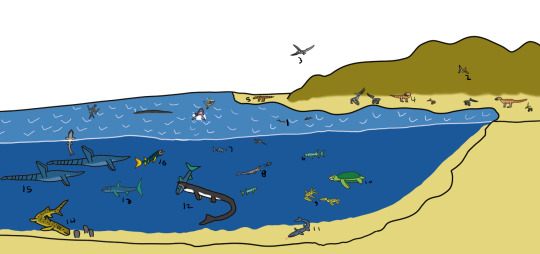
A Day in Niobrara
1. Hesperornis regalis 2. Nyctosaurus gracilis 3. Pteranodon longiceps 4. Claosaurus agilis 5. Niobrarasaurus coleii 6. Gillicus arcuantus 7. Enchodus petrosus 8. Platecarpus tympaniticus 9. Dolichorhynchops osborni 10. Protostega gigas 11. Clidastes prophython 12. Tylosaurus proriger 13. Bonnerichthys gladius 14. Ptychodus mortoni 15. Styxosaurus snowii 16. Xiphactinus audax 17. Cretoxyrhina mantelli
#niobrara#hesperornis#nyctosaurus#pteranodon#claosaurus#niobrarasaurus#gillicus#enchodus#platecarpus#dolichorhynchops#protostega#clidastes#tylosaurus#bonnerichthys#ptychodus#styxosaurus#xiphactinus#cretoxyrhina
3 notes
·
View notes
Text
Critter of the Month: Diplodocus
Critter of the Month: Diplodocus
Meet Dippy! A giant with a heart of gold, life is never boring when this big guy is around. Nothing is out of reach! He’ll stick his nose into everything until every mystery is solved. Happy Holidays! I hope you’ve been having a joyful and restful holiday season, or at least as restful as the holidays can get! 🙂 (more…)

View On WordPress
#Allosaurus#Art#characters#Christmas#critter page#dinosaur#Diplodocus#Dippy#doodles#Enchodus#Holidays#Sauropod#Scutellosaurus#Skittles#winter
3 notes
·
View notes
Photo

Almost-Living Fossils Month #02 -- The Saber-Toothed “Herring”
First appearing in the mid-Cretaceous, about 113 million years ago, Enchodus was a small-to-medium-sized genus of predatory fish. Different species ranged from a few centimeters to up to 1.5m in length (4′11″), with Enchodus gladiolus here being an averaged-sized example at about 60cm long (2′).
The most distinctive feature of these fish were the enlarged fang-like teeth in both their upper and lower jaws, over 6cm (2.4″) long in the largest individuals, which may have been a specialization for feeding on soft-bodied cephalopods.
Despite having been nicknamed “saber-toothed herrings”, they weren’t actually closely related to herrings at all, instead being part of the aulopiformes -- a group also containing modern lizardfish, lancetfish, and a different type of sabertooth fish.
Fossils of various Enchodus species have been found all over the world, and they seem to have been very common and important members of ancient marine ecosytems, occupying mid-level carnivore niches and in turn being eaten by other predators. Their remains have been identified within the preserved stomach contents of marine reptiles such as plesiosaurs and mosasaurs, as well as sharks and hesperornithean birds.
These toothy fish survived through the end-Cretaceous mass extinction and continued their success for almost 30 million years into the Cenozoic, with the last known fossils dating to just 37 million years ago in the Late Eocene. They probably didn’t survive much longer beyond that date, since there was an extinction event at the Eocene-Oligocene boundary (~34 mya), a period of sudden cooling that affected many marine animals at the time.
#almost living fossils month#science illustration#paleontology#paleoart#palaeoblr#enchodus#enchodontidae#saber-toothed herring#aulopiformes#actinopterygii#fish#art
123 notes
·
View notes